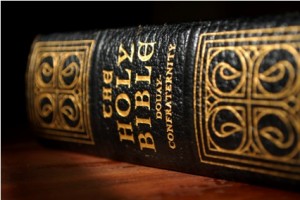The Challenge — Jesus Offers a New Vision for God’s People
Editor’s Note — Part 4 of Jesus, Kingdom Builder, a 13-part study of St. Matthew’s Gospel by Dr. Sri. The series will run every other Friday.

Photography © by Andy Coan
The famous “Sermon on the Mount” (Mt. 5:7) is known for its beautiful spiritual and moral teachings. Indeed, it would be hard to beat a sermon that had the Beatitudes, the Our Father, and the command to love your enemy and be light to the world all packed into one.
One thing, however, which is not commonly noted about the Sermon on the Mount is how its explosive message would have shaken the world of many people who heard Jesus’ words on the hillside that day.
A New Vision
“Love your enemy.” “Blessed are the merciful.” “Turn the other cheek.” With these words, Jesus was not simply setting forth a brand new ethical standard. While Christ’s teachings in the Sermon on the Mount certainly have great moral applications for Christians of all ages, we must see how Jesus was giving a very specific challenge to the people of His day. Jesus was offering a new vision-a new vision for what it meant to be God’s people.
National Crisis
The Jews in Jesus’ day were living in hard times. They were facing a national crisis. Roman rulers controlled their land, took their money, and raped their women. Many of the Jewish priests and local leaders were assassinated and replaced by handpicked appointments from Rome or Herod. Thousands of Jews who tried to resist Roman rule quickly paid the severe price of death.
This oppressive environment created numerous challenges for those who were striving to remain loyal to God’s covenant. According to the Torah, God alone was king and He would rule His people through a descendant of King David. No foreigner was to rule over the Jews (Deut. 17:15). Would submitting to Caesar, Pilate, or Herod betray Yahweh’s lordship?
Then came the question of taxes and tithes. With the Romans imposing heavy tax burdens, it would be quite difficult for many Jews to be able to pay both the taxes to Caesar and the tithe, which their own law required them to give to God. So should one be faithful to Rome or to Yahweh?
Also, there was the danger of assimilation. When the Romans imported thousands of their own citizens, with their pagan practices and lifestyles, right into the midst of Jewish society, it became increasingly difficult for Jews to maintain their identity as God’s holy people set apart from the nations. Any time a smaller culture is enveloped by a larger, dominating culture, assimilation is a real threat. Thus, Jewish self-preservation was a critical issue in the time of Jesus.
Diverse Strategies
The Jewish people responded to this crisis in different ways. While they all believed that one day God would rescue those who remained faithful to the covenant, there were diverse opinions about who those faithful Jews would be. One burning question in first-century Judaism was:
“What did it mean to be a true, loyal Jew during this time of oppression?”
One group, the Pharisees, said faithfulness meant imitating God’s holiness. In Hebrew, “holy” literally means “set apart” or “separated,” and the Pharisees imitated God’s holiness by separating themselves from anything or anyone that was unholy. They did this through strict observance of the laws that distinguished the Jews from their pagan neighbors. Thus, they avoided certain types of foods, certain types of animals, certain types of utensils and, most of all, certain types of people, such as sinners, tax collectors, and gentiles (non-Jews). Little details such as these-what you ate, how you ate it, and with whom you ate-were all powerful political and religious symbols. These were symbolic ways of expressing faithfulness to God’s covenant in the midst of a growing pagan culture. They were ways of saying, “I am not like the pagans. I am a true Jew, part of God’s faithful people.”
The Essenes were another group who emphasized separateness – but to an even greater degree. They called for separation from society altogether. With Roman occupation and corrupt Jewish leaders in Jerusalem, remaining holy within society was no longer a possibility. So the Essenes withdrew to the desert, where they established a monastic-like community, claiming to be the only Jews left who were still faithful to God’s covenant.
Other Jews believed holiness could be obtained only by driving the Romans out of the land. These revolutionaries stressed that only Yahweh was meant to be king over Israel. To submit to Caesar or Herod would be to reject God’s role as Israel’s true king. Thus, many Jews were ready to take up arms against the Romans when the time was right.
Setting the Stage
One can see there was much diversity in first-century Judaism. Although most people believed that God would rescue the loyal Jews during the time of the Messiah, there were various opinions about what it meant to be the type of Jew who would be part of that faithful remnant when the kingdom finally arrived. This was the complex stage onto which Jesus walked when He began His kingdom movement in a northern part of Israel called Galilee, preaching “Repent, for the kingdom of heaven is at hand” (Mt. 4:17).
Go Tell It on a Mountain
From the beginning, Jesus’ public ministry took off like lightning. People from all over Galilee and beyond flocked to see Him. Why was He so popular? His message and His actions said it all: The long-awaited kingdom was now arriving (Mt. 4:17, 23-25). Jesus was offering a message the Jews were longing to hear. With eager anticipation, many Jews began to place their hopes in Him to rescue them from their enemies and restore the kingdom to Israel. No wonder Jesus’ fame spread throughout the region so rapidly!
After attracting this large following, Jesus decided to lead the crowds up a mountain in Galilee for a special discourse about the kingdom. This action itself might have led some of His followers to ponder what might happen next. In those days, the hill country of Galilee was a refuge for Jewish revolutionaries who were plotting their assaults against foreign oppressors. The caves in those hills made for good hiding places. Not too long ago, a group of bandits had hidden in the Galilean hills during a fierce conflict with King Herod.
So when Jesus led His followers up a mountain in Galilee, perhaps some might have wondered whether He was going to start some type of revolt of His own – like Judas the Galilean had done in the Galilean hillside one generation ago. Was Jesus going to make a claim to be Israel’s king and lead the people in a fight for the kingdom? The crowd waited for Him to speak.
The Kingdom Movement
Jesus then began to address His band of followers on the mountainside with a startling surprise. He introduced an unexpected lineup of people who would be blessed in the kingdom He was building: “Blessed are the merciful . . . Blessed are the peacemakers . . . Blessed are those who are persecuted.”
What a shock. What kind of kingdom movement was this? Jesus seemed to be blessing all the wrong people. The peacemakers, the merciful, and the persecuted were not the expected first-round draft choices for a kingdom-building team. Many Jews would have preferred vengeance over mercy, vindication over persecution, fighting for freedom over making peace.
Consider a few other famous commands in the Sermon on the Mount, such as “love your enemy,” “pray for those who persecute you,” and the so-called “go the extra mile.” Sometimes these teachings are misunderstood as practical instructions for becoming pushovers for Jesus. But in their first century context, these challenges would have been much more intense. Jesus was subverting the revolutionary and nationalistic tendencies within first-century Judaism.
The Challenge
For example, “love your enemy” was not simply an abstract principle to be applied when you had to face someone who wanted to do you harm. Rather this command had a specific, concrete meaning for the Jews who heard His teaching that day. For those original listeners, “love your enemy” would have sounded something like: “Love the Romans who persecute you. Love Herod and his illegitimate, violent monarchy. Do not join the revolt movements.”
Similarly, the command, “If any one forces you to go one mile, go with him two miles” was not simply a lesson on being generous. Roman soldiers often forced civilians to carry their gear for one mile. Using this image, Jesus challenged the Jews to view the Romans not as adversaries to be overcome, but as brothers and sisters who are to be loved and won over for God.
In fact, that was Israel’s mission from the very beginning: to be light to the world and salt of the earth (Mt. 5:13- 14; Is. 42:6, 49:6; Ex. 19:6). Jesus challenged the people to return to their roots and be what Israel was always meant to be-not an exclusive, nationalistic religion isolated from the other nations, but a priestly kingdom serving and leading the gentiles to worship of the one true God.
Light of the World
Israel was meant to be light to the world, God’s instrument to bless the nations. But in the time of Jesus, many had lost sight of Israel’s worldwide mission. Israel’s light had turned inward on itself, focusing more on remaining pure and separated from the pagans-as in the Pharisaic and Essene programs-or intent on driving out the Romans with force, as in the resistance movement. How could Israel be light to the world if they were more concerned about fighting it off?
Jesus shattered the prevailing views of the day with this challenge: “You are the light of the world. A city set on a hill cannot be hid. Nor do men light a lamp and put it under a bushel, but on a stand, and it gives light to all in the house. Let your light so shine before all men” (Mt. 5:14-15).
The way of the kingdom was the way of peace, and it involved gathering together all peoples, even the Jewish oppressors. Rome and Herod were not enemies to be conquered, but brethren to be gathered back into God’s covenant family.
The Two Ways
Matthew’s Gospel highlights how Jesus is a new Moses. Both Jesus and Moses escaped an evil ruler’s decree to kill Israelite children by going to the Egyptians. Both came out of Egypt to return to Israel. Both went out into the desert, Moses for 40 years and Jesus for 40 days. More Mosaic parallels are found in Jesus’ first and last discourses: the Sermon on the Mount (Mt. 5:7) and His confrontation with the Pharisees in the temple (Mt. 23).
Consider this: Before his death, Moses gave the people of Israel the covenant of Deuteronomy just when they were getting ready to enter the Promised Land after 40 years in the wilderness. In his parting words, Moses left Israel with a choice: faithfulness or unfaithfulness to the covenant, life or death, blessing or curse:
“I have set before you life and death, blessing and curse; therefore choose life, that you and your descendants may live, loving the LORD your God, obeying his voice, and cleaving to him.” (Deut. 30:19-20)
Moses gave instructions for this covenant to be announced and ratified on two mountains after the people entered the land. Half the tribes of Israel shouted out the covenant blessings on Mount Ebal, while the other half proclaimed the curses on Mount Gerizim (Deut. 27:11-13). Israel had to choose which path she would follow. Faithfulness would bring blessing upon Israel in their land. Unfaithfulness would invite the curses and expulsion from the land. They chose the later, and Jews in the time of Jesus believed they were still suffering the consequences of their sin in their experience of foreign oppression.
In similar fashion, Jesus announced blessings and curses from two different mountains of His own. He offered seven blessings in the beatitudes on the Galilean mountain at the beginning of His ministry (Mt. 5:3-12). And He announced seven curses on the Temple Mount in Jerusalem near the end of His ministry. There, Jesus pronounced the seven “woes” on those scribes and Pharisees who rejected His kingdom program (Mt. 23:13-36). [1]
The message is clear. Once again, Israel was faced with a vital decision. Like Moses, Jesus forced the Jews of His day to make a choice: Do you want to follow the way of the revolutionaries and separatists? Or will you follow My way, the way of mercy, peace, and enduring persecution in a way that is restorative. The first way will lead to Israel’s destruction. The latter will lead to the kingdom’s restoration. Ultimately for Jesus, as we will see, the road to the kingdom is the way of the Cross.
Footnotes:
[1] P. Ellis, Matthew: His Mind and His Message (Collegeville, MN: Liturgical Press, 1974), 81
Questions for Discussion:
- The Pharisees are often stereotyped as too ritualistic or promoting a program of self-salvation. How might at least their intention to rigorously follow the details of the law be viewed positively in light of the first-century Jewish crisis?
- How would you have responded to the crisis if you were a Jew in the time of Jesus? Would you have followed the Pharisees? The Essenes? The revolutionaries? How open do you think you would have been to the kingdom Jesus was initiating?
- St. Paul describes the Church as the new Israel of God (Gal. 6:16). How is the Catholic Church the fulfillment of God’s plan for Israel? In what ways is the Catholic Church the “light of the world”? What specifically can we do to let our light shine before all?
Acknowledgement:
Reprinted with permission from the April 1999 issue of Lay Witness magazine. © 1999 Catholics United for the Faith / www.cuf.org/Laywitness/index.asp
Please help us in our mission to assist readers to integrate their Catholic faith, family and work. Share this article with your family and friends via email and social media. We value your comments and encourage you to leave your thoughts below. Thank you! – The Editors













